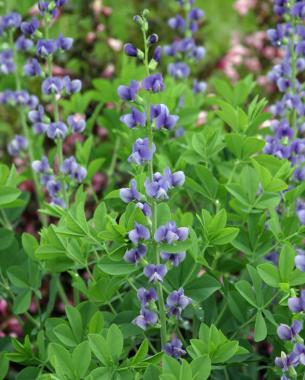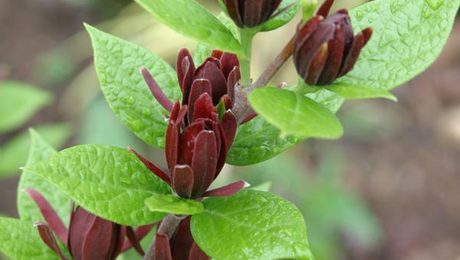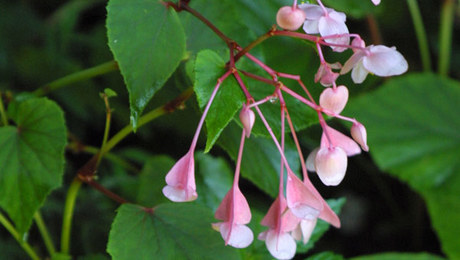If you know the genus and species of this month’s mystery plant, you could win a free one-year subscription to Fine Gardening. Send your entry, along with your complete mailing address, by March 31, 2009 to [email protected]. The winner will be chosen at random from all correct entries.

Photo/Illustration: Steve Aitken
Last month’s mystery plant was Baptisia australis, commonly known as false indigo. This perennial is native to the eastern United Statesand has rounded, deep green leaves on plants up to 5 feet tall and 2 feet wide. In early summer the plant bears spikes of deep blue-purple flowers that give way to highly decorative, deep-gray seed pods that are useful in flower arrangements. False indigo prefers full sun and well-drained, sandy soil. It is hardy in USDA Hardiness Zones 3 to 9. Robbie Billings of Speedwell, Tennessee, was chosen at random from all correct entries to receive a free one-year subscription to Fine Gardening. Congratulations, Robbie!
What eLetter subscribers have to say about Baptisia australis:
“I love this perennial!” -Casey Evelo, Concord, North Carolina
“I have admired this plant for years for its graceful form and clear blue blossoms, and always wanted to grow it. I finally have one that seems to have survived the winter, but will it boom this year? Hurry, spring!” -Nadine Thacker, Shelby Twp, Michigan
“This plant has a beautiful blue green leaf that looks good all season! A must have for a sunny spot with poor soil.” -Lynn S. Pennett, Downingtown, Pennsylvania
“We had baptisia at our former home and I just loved them. I hope to add them to the gardens at our new home soon!” -Mari Lane Gewecke, Lincoln, Nebraska
“This is Baptisia australis, one of my favorites. My parents grew it when I was growing up, and I loved to watch the bumblebees hover around it. I tried to grow it in my Rhode Island garden but had no luck. Seeing the picture makes me want to try again, despite our very acidic soils.” -Carol King, Bristol, Rhode Island
“I had a chance to save some from a construction site but didn’t get back in time. Have been kicking myself ever since!!” -Becky Gamble, Southlake, Texas
“I love this plant!” -Mrs. J. E. Arocho, Fairless Hills, Pennsylvania
“I have always loved this plant, but it’s hard to grow in California.” -Kathy Rasmussen, Salinas, California
“Not only does it have beautiful blue flowers that create interesting seed pods, but it’s also a legume, which enables it to grow in very tough conditions, like the south-facing slope we have where there is very little topsoil over rubble that the builder used as fill. I love it!” -Katherine Holland, North Easton, Massachusetts
“I call this plant false indigo. It became my favorite after planting it 18 years ago. It never fails and expands a small bit each spring, but does not really invade the rest of the garden as some of my plants do.” -Mary Lou Parsons, Three Rivers, Michigan
“Tried growing this from seed last year. Think it needs a little time to mature.” -Monica Hull, St. Peters, Missouri
“I have one in my garden that I started from seed years ago. When it gets too large for its space I dig it up and start over!” -Peggy Armstrong, Battle Creek, Michigan
“A perennial in the lugume family that reminds me somewhat of lupine. It makes a nice cutflower!” -Susan Tharp, Clackamas, Oregon
“I love this plant and have two plantings that are six years old. They have not spread in width but get over 4 feet every year. Very hardy, drought tolerant plants and these I planted in full sun. I put tomato rings over them in the spring as soon as I see the shoots begin to break from the soil; I forgot to do this one year and lets just say that trying to place the rings after the plant has reached 2 to 3 feet high is not fun! There is also a natural hybrid of the species in white and I have two planted in light shade. These plantings are about 4 years old and just bloomed a little last year. I would like to move them to a sunnier bed, but have read that they do not transplant well. Even when not flowering, the foliage is such a beautiful blue-green and a good background foil for the rest of the bed.” -Kathy Young, Georgetown, Delaware
“It grows beautifully and luxuriantly in the cottage garden outside the window of my converted one-room schoolhouse home in northern Vermont. My daughter-in-law, an artist, planted it, when they lived here as their first home. The foliage is so attractive in arrangements, too.” -Wendy Andersen, Jericho, Vermont
“It is a large plant which, unfortunately, has not thrived in my garden since the deer munch it down each year. Some say it is deer resistant but that has not been my experience.” -Pamela Carter, Milford, Michigan
“I’ve had mine for about 12 years, and it is about 4 feet wide. I love to use the pods for Halloween bouquets with Chinese lanterns.” -Dori Miller, Palatine, Illinois
“I recognized this plant immediately because I have several varieties growing in my perennial garden.” -Annette Chinuge, Springfield, Illinois
“I was told it was quite easy to grow in poor soil as long as it remained undisturbed, but I have tried it on 3 occasions without success. Worth growing for the lovely blue/green foliage alone.” -Georgette Willix, Atlanta, Georgia
“I have a beautiful specimen of ‘Purple Smoke’ in front of my ‘Blanc Double de Coubert’ rugosa rose-it’s gorgeous when they bloom together. An added bonus-the deer won’t touch either one.” -Cynthia McCain, Frederick Maryland
“I enjoy its flower spikes, as well as the blue-green shrub-like foliage and form for the rest of the summer. A must-have plant for me!” -Donna Gisch, Farmington, Minnesota
“I’ve never had a place for this gorgeous plant but a good friend has one decorating her entrance way, where it bakes in the sun, and it has filled that bed gloriously!” -Barbara Coven-Ellis, Chelsea, Michigan
“I have some growing in my front yard that my husband dislikes because he thinks it gets too “wild” looking, but I just love the blue!” -Marilyn Hill, Frisco, Texas
“It is a beautiful native perennial with pretty blue flowers in spring followed by interesting seed pods and great fall color. Tough and tolerant of heat, humidity, and drought, false indigo is also a traditional dye plant. What’s not to love! Thanks for including some natives in the last couple of mystery plants. They help support our native pollinators and other beneficial fauna.” -Catherine Mitchell, Gastonia, North Carolina
“I’ve had this plant in my garden for years. It’s beautiful when it blooms and I love the structure and leaves as a fill-in plant in my garden bed. I’ve left the seed heads to develop on occasion, but I usually cut them off to keep the plant upright and not pulled over with heavy seed pods. It needs very little care otherwise.” -Mary Chapman, Allen Park, Michigan
“I have seen it growing wild in many of our parks and nature reserves here in Michigan.” -Marilyn Hanks, Grand Rapids, Michigan
“While I have no experience with growing baptisias, I’ve always liked their foliage. It looks so fresh!” -Brieannon Akins, Jacksonville, Florida
“I love this plant! I grew it two houses ago-wish I had a good spot for it now.” -Barbara Richmond, Bartonville, Illinois
“Hooray, one I know and love. I’ve even planted it from seed!” -Monica Milla, Ann Arbor, Michigan
“It’s one of those perennials that looks great from Spring through Fall, for the seed pods are also quite interesting. It spreads a bit, but the little seedlings are easy enough to pull. The plant is nearly impossible to transplant, so it’s best to ponder where you will site it.” -Lynn Taggart, Marblehead, Massachusetts
“One of my favorites! A great xeric plant as long as the deer don’t get it.” -Cathy Regan, Boulder, Colorado
This is Baptisia australis, one of our many fine natives that is available in the nursery trade. This blue one is pretty rare in the wild, so I’m told, but makes a wonderful long lived, drought tolerant addition to the perennial or wild garden. And, it’s a legume!” -Lisa Tompkins, Waxhaw, North Carolina
“My own version of this came from seeds from my Aunt Edna’s garden in Traer, Iowa. Subsequent generations have moved with us from Edgewood, Maryland to Leesburg, Virginia to Chapel Hill, North Carolina and now Hillsborough, North Carolina. For many years we just knew it by the name “Aunt Edna’s Sweet Peas'”until I learned its real name to be false indigo or Baptisia australis. Whenever I see it in my garden, I think of my aunt and growing up in Tama County, Iowa.” -Susan Hardisty, Hillsborough, North Carolina
“I happen to be starting them indoors from seed this year. Wish me luck!” -Erin Jones, Wilson, Wisconsin
“I have one that comes up each year in my Wyoming garden, but hardly ever blooms.” -Phillippa K. Lack, Cheyenne, Wyoming
“I haven’t had a chance to grow this plant, but it’s always been on my wish list to try someday.” -Liz King, Boise, Idaho
“I have grown baptisia for many years and find it to be a valuable plant in my garden. I would like a yellow variety, but haven’t found one in that fits within my budget as yet.” -Colleen Janney, Lacey, Washington
“It can grow into a huge plant and is just gorgeous!” -Ellen Gagliardi, Maineville, Ohio
“I have two in my shady garden here in the Buckhead area of Atlanta. One is small, sparce, and blooms, and the other is robust, full, and never blooms. They must require a lot more sun than my garden provides.” -Peggy Witt, Atlanta, Georgia
“Mine is about three years old, planted in full sun, sandy soil, Zone 4. It is spectacular in the spring time. I only wish I had more room to try the newer varieties. It gets the most comments from garden visitors when it is blooming in May. The foliage stays very nice all summer long and I haven’t had any insect damage on it at all.” -Brenda Gens, Madelia, Minnesota
“A lovely plant. I’ve enjoyed it and also the screaming yellow variety.” -Neil Tolsma, Menomonee Falls, Wisconsin
“I have this lovely plant growing in my garden. The flowers are long-lasting and have a good vase life. It is one of my favorite plants.” -Joyce Mahajan, Oswego, New York
“It is one of by all time favorite plants!” -Ronda Roth, Waukesha Wisconsin
“I absolutely adore this plant! The flowers look like blue jelly beans and it grows beautifully under my maple tree. The black seedpods are quite attractive as well.” -Valerie Mahnic, Guelph, Ontario
“I had one for four years, and last year it finally bloomed-one stinky little flower spire, for all that leafy volume. Clearly, it should be labeled FULL sun, because it did not respond to the 5.5 hours of sun it received in my garden. Love the plant, but disappointed in it; finally, I yanked it out.” -Jackie Barchilon, Westport, Connecticut
“Don’t make the mistake I made by planting in part sun-it’s full sun or nothing-at least here in Charlotte. -Susan Wall, Charlotte, North Carolina
“It is a beautiful perennial, and I use it as a substitute for lupines, since it does not have mildew problems that lupines are notorious for.” -Marinda Parks, Beaverton, Oregon
Contest Rules
The winner will be chosen at random from all correct entries. The correct answer and winner will be announced on the following eLetter’s contest page. In the event there is no correct response, no prize will be awarded. The Taunton Press is not responsible for system breakdowns or lost emails.
This contest is open to legal residents of the 50 United States or the District of Columbia who are 18 years of age or older. Employees, officers, and directors of The Taunton Press, its subsidiaries, affiliated companies, dealers, advertising and promotion agencies, their respective employees, officers, directors and agents, and those associated with the development, distribution or implementation of this Contest, their immediate families (including parents, in-laws, siblings, children or spouse, regardless of where they live) and members of the same household, whether related or not, are not eligible to participate. VOID WHERE PROHIBITED. Winners agree to allow The Taunton Press to use their name in conjunction with this contest and subsequent promotion.
Prize:
The winner will receive a free one-year subscription to Fine Gardening magazine. If the winner is a current subscriber, a year will be added to his/her subscription term. The prize is non-transferable, and no cash substitutions will be made. The total value of this prize is $29.95. All taxes are the responsibility of the prize winner.

















Comments
Log in or create an account to post a comment.
Sign up Log in